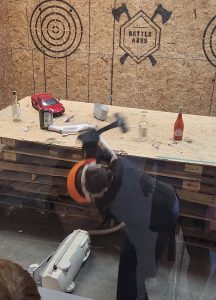NEW LOCATION OPEN NOW!
Battle Axes Entertainment Venue
Discover and experience the best in entertainment in Lexington KY. Enjoy High Speed Electric Go-Kart Racing (40mph), Indoor Racing Zip Lines, Axe Throwing, Bowling, Footbowl and Rage Room. Relax and unwind with a variety of foods, one of the best pizzas in town and our fully loaded bar with over 100 varieties of beers, ciders and seltzers. Kids can enjoy our giant inflatables, toddler area, arcade, cornhole and much more! Click the button above to learn more about all of our Attractions.
We look forward to seeing you!
DIRECTIONS
Turn directly onto Turner Commons Way off of Leestown Rd./W. Main Street between Stuttgart Motors and the Bridge. It is a gated entrance. Go to the bottom of the hill and veer left. We are straight ahead.

AXE THROWING

BOWLING

HIGH SPEED GO KARTS

RACING ZIPLINES

RAGE ROOM

